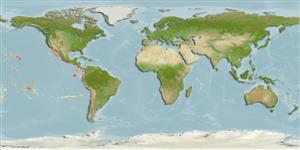Elasmobranchii (Haie und Rochen) (sharks and rays) >
Squaliformes (Sleeper and dogfish sharks) >
Etmopteridae (Lantern sharks)
Etymology: Centroscyllium: Greek, kentron = sting + Greek, skylla = a kind of shark (Ref. 45335).
More on author: Garman.
Environment: milieu / climate zone / depth range / distribution range
Ökologie
seewasser benthopelagisch; tiefenbereich 269 - 1170 m (Ref. 96339). Deep-water; 32°N - 30°S
Eastern Pacific: Hawaiian Islands, southern California (USA), Panama, Cocos Island (Costa Rica), Colombia, Ecuador, northern and central Chile, and the Galapagos Islands. Has been confused with Etmopterus granulosus (Günther, 1880) and Centroscyllium granulatum (Günther, 1887), but is quite distinct.
Size / Gewicht / Alter
Maturity: Lm ? range ? - ? cm
Max length : 51.0 cm TL Männchen/unbestimmt; (Ref. 96339)
A little-known deepwater dogfish found on the continental and insular slopes. Incidentally caught in sablefish (Anoplopoma) traps but not utilized. Feeds chiefly on other fishes and invertebrates (Ref. 28023). Ovoviviparous (Ref. 205).
Life cycle and mating behavior
Geschlechtsreife | Fortpflanzung | Ablaichen | Eier | Fecundity | Larven
Distinct pairing with embrace (Ref. 205).
Compagno, L.J.V., 1984. FAO Species Catalogue. Vol. 4. Sharks of the world. An annotated and illustrated catalogue of shark species known to date. Part 1 - Hexanchiformes to Lamniformes. FAO Fish. Synop. 125(4/1):1-249. Rome, FAO. (Ref. 247)
IUCN Rote Liste Status (Ref. 130435)
Bedrohung für Menschen
Harmless
Nutzung durch Menschen
Fischereien: nicht kommerziell
Mehr Information
ReferenzenAquakulturAquakultur ProfilZuchtlinienGenetikElectrophoresesVererbbarkeitKrankheitenVerarbeitungNutrientsMass conversion
PartnerBilderStamps, Coins Misc.LauteCiguateraGeschwindigkeitSchwimmstilKiemenoberflächeOtolithsGehirngrößeSehfähigkeit
Tools
Zusatzinformationen
Download XML
Internet Quellen
Estimates based on models
Preferred temperature (Ref.
123201): 6.6 - 9.9, mean 8 °C (based on 44 cells).
Phylogenetic diversity index (Ref.
82804): PD
50 = 0.5078 [Uniqueness, from 0.5 = low to 2.0 = high].
Bayesian length-weight: a=0.00372 (0.00188 - 0.00734), b=3.10 (2.92 - 3.28), in cm total length, based on LWR estimates for this (Sub)family-body shape (Ref.
93245).
Trophic level (Ref.
69278): 3.9 ±0.56 se; based on food items.
Widerstandsfähigkeit (Ref.
120179): niedrig, Verdopplung der Population dauert 4,5 - 14 Jahre. (Fec assumed to be <100).
Fishing Vulnerability (Ref.
59153): Moderate vulnerability (40 of 100).
Nutrients (Ref.
124155): Calcium = 6.46 [1.11, 35.03] mg/100g; Iron = 0.217 [0.049, 0.765] mg/100g; Protein = 17.3 [15.0, 20.0] %; Omega3 = 0.292 [0.094, 0.949] g/100g; Selenium = 15.5 [3.7, 55.0] μg/100g; VitaminA = 23.9 [3.9, 143.4] μg/100g; Zinc = 0.503 [0.225, 1.077] mg/100g (wet weight);
